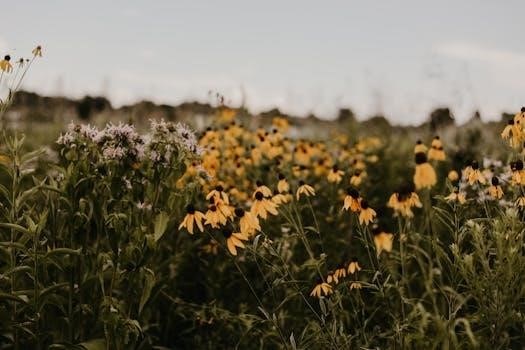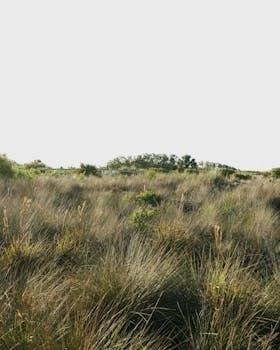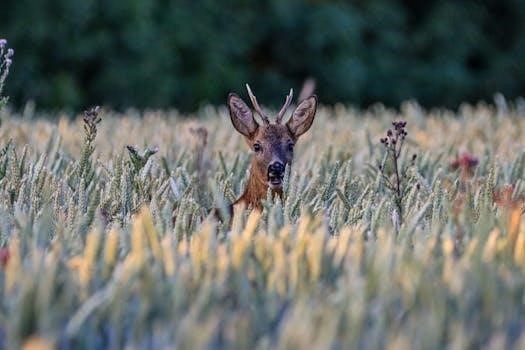Transform your garden into a vibrant ecosystem with prairie plants! This guide offers expert tips and techniques for successful cultivation. Embrace biodiversity and ecological balance by nurturing a wildlife-friendly habitat with resilient flora. Discover the beauty of native prairie plants, perfectly suited for your landscape.
What is a Prairie Garden?
A prairie garden is a landscape design that mimics the natural grasslands of North America. It is characterized by a diverse mix of native grasses and flowering perennials, creating a relaxed, meadow-like appearance. These gardens aim to capture the wild beauty of prairies while offering a low-maintenance and ecologically beneficial alternative to traditional lawns and manicured landscapes.
Prairie gardens are more than just aesthetically pleasing; they are designed to support local ecosystems. By utilizing native plants, these gardens provide food and habitat for pollinators like bees and butterflies, as well as birds and other beneficial insects. They contribute to biodiversity and create a sustainable landscape that connects your garden to the broader environment.

The plants in a prairie garden are typically non-woody, or herbaceous, and adapted to the local climate, meaning they require less water and maintenance once established. The design encourages a natural look, with plants arranged in drifts and swaths, rather than formal rows. The goal is to create a landscape that feels effortless and wild, while still requiring thoughtful planning to achieve the right balance and overall effect.
Benefits of Prairie Plants
Prairie plants offer a multitude of benefits, making them an excellent choice for environmentally conscious gardeners. Their native adaptation means they are naturally drought-tolerant, pest-resistant, and adaptable to low-nutrient soils, reducing the need for excessive watering, fertilizers, and pesticides. This not only saves resources but also promotes a healthier environment.
These plants play a crucial role in supporting local ecosystems. They provide essential food and habitat for native pollinators, such as bees, butterflies, and other beneficial insects, contributing to biodiversity and a thriving garden ecosystem. By attracting pollinators, prairie plants enhance the pollination of other plants in your garden and surrounding areas.
Beyond their ecological advantages, prairie plants offer aesthetic appeal throughout the seasons. Their diverse textures, colors, and forms create a dynamic and visually interesting landscape. Many prairie plants bloom at different times, ensuring a continuous display of flowers from spring through fall. Some even offer winter interest with their seed heads and foliage, providing year-round beauty. Furthermore, they require less maintenance than traditional gardens, saving time and effort while providing a beautiful and sustainable landscape.

Prairie Garden Design Principles
Designing a prairie garden involves understanding key principles that mimic natural grasslands. Start by selecting native plants adapted to your local climate and soil conditions. Prioritize diversity, incorporating a mix of grasses and flowering perennials to create a balanced ecosystem. Consider the mature sizes of plants, placing taller species at the back and shorter ones in front to ensure visibility.
Embrace natural patterns by creating drifts or swaths of plants rather than isolated groupings. This mimics the way plants grow in a prairie. Allow for open spaces to create a relaxed, meadow-like feel. Pay attention to bloom times to ensure continuous color throughout the growing season. Combine plants with different textures and forms for visual interest.
Consider the overall aesthetic you want to achieve, whether a formal or informal prairie garden. Use pathways and other design elements to create structure and guide the eye. Incorporate natural materials such as rocks and wood to complement the plants. Create a design that provides year-round interest. Plan for the changing seasons, selecting plants with attractive seed heads or fall foliage. By following these design principles, you can create a beautiful, sustainable, and wildlife-friendly prairie garden.
Top Prairie Plants for Your Garden
Creating a stunning prairie garden involves selecting the right mix of native plants; Begin with grasses like Blue Grama, a compact variety with unique horizontal flowers, and Northwind Switch Grass, offering strong vertical interest. Prairie Dropseed adds a fine texture and graceful form. These grasses provide structure and movement throughout the year.
Enhance the garden with flowering perennials such as Blue Star, known for its spring blooms and golden fall foliage. Goldenrod Fireworks offers arching sprays of golden-yellow flowers in late summer. Black-Eyed Susan brings cheerful, daisy-like flowers from mid-summer to fall. Culver’s Root adds vertical interest with tall spikes of white or lavender flowers. Joe Pye Weed attracts butterflies with its pink, fragrant flower clusters in late summer.
Purple Coneflower is a prairie classic, offering long-lasting blooms and attracting pollinators. Aromatic Aster extends the season with clouds of lavender-blue flowers in the fall. These plants are not only beautiful but also provide essential resources for local wildlife, making your garden a thriving ecosystem.
Blue Grama
Blue Grama (Bouteloua gracilis ‘Blonde Ambition’) is a standout choice for adding unique texture to prairie gardens. This compact grass is celebrated for its distinctive horizontal eyebrow flowers that elegantly float above its foliage, creating a visually appealing display. Growing to a height of approximately 30 inches and spreading about 18 inches wide, Blue Grama is perfectly suited for smaller garden spaces or as a foreground plant in larger designs.
Its manageable size makes it versatile for various landscaping applications. Thriving in full sun, Blue Grama demonstrates impressive drought tolerance, making it an ideal selection for regions with limited rainfall or for gardeners seeking low-maintenance options. Its adaptability extends to various soil types, further enhancing its appeal for a wide range of garden settings.
Blue Grama’s unique texture and eye-catching flowers add a touch of elegance to prairie gardens. ‘Blonde Ambition’ is favored for its reliable performance and aesthetic appeal. The plant ensures that it remains a popular choice among gardeners who seek to incorporate native grasses into their landscapes.
Northwind Switch Grass
Northwind Switch Grass (Panicum virgatum ‘Northwind’) is a remarkable variety that brings strong vertical interest to any garden setting. Its defining characteristic is its steel-blue foliage, which forms strikingly upright columns. These columns can reach an impressive height of up to 6 feet, while maintaining a relatively narrow width of about 18 inches, making it an excellent choice for adding structure without taking up excessive space.
In the late summer months, Northwind Switch Grass produces delicate, wispy flowers that appear gracefully atop the foliage. These flowers add another layer of texture and visual appeal to the plant, further enhancing its ornamental value. This grass is particularly well-suited for creating a sense of height and architectural form in the garden.
Northwind Switch Grass thrives in full sun and is known for its adaptability to various soil types, making it a versatile option for different garden conditions. Its upright habit and attractive foliage make it a standout choice for creating screens, borders, or focal points in the landscape. Gardeners value this grass for its low maintenance requirements and its ability to provide year-round interest, with the foliage often retaining its form well into the winter months.

Prairie Dropseed
Prairie Dropseed (Sporobolus heterolepis) is a fine-textured grass that lends a graceful, fountain-like appearance to prairie gardens. This native grass typically grows to about 3 feet in both height and width, making it a versatile choice for various garden sizes and designs. Its delicate texture and arching form create a soft, flowing effect that complements other prairie plants beautifully.
In late summer, Prairie Dropseed produces delicate, airy flowers that rise above the foliage, adding another layer of visual interest. These flowers are known to emit a faint, sweet cilantro scent, adding a unique sensory experience to the garden. As the seasons transition into fall, the foliage of Prairie Dropseed transforms into a stunning bronze color, providing exceptional winter interest.
This grass is exceptionally drought-tolerant, making it an excellent choice for gardeners in drier climates or those seeking low-maintenance options. Prairie Dropseed thrives in full sun and prefers well-drained soils. Its ability to withstand dry conditions and its attractive form make it a popular choice for creating borders, mass plantings, or as a standalone specimen. Gardeners appreciate its resilience and its ability to provide year-round beauty to the prairie garden.

Maintaining Your Prairie Garden
Prairie gardens, while known for their low-maintenance nature, do require some attention to thrive and maintain their desired aesthetic. Proper maintenance ensures the health and vigor of your plants, prevents unwanted spread, and enhances the overall beauty of your prairie landscape. Key aspects of maintenance include weed control, occasional watering, and selective pruning.
Weed control is essential, especially during the first few years as your prairie plants become established. Regularly remove unwanted plants by hand or with appropriate tools to prevent them from competing for resources. Once established, prairie plants are generally resilient and can outcompete many weeds. Watering is typically only necessary during prolonged dry periods, as most prairie plants are drought-tolerant. However, supplemental watering may be needed for newly planted specimens to help them establish strong root systems.
Pruning is another important aspect of prairie garden maintenance. Remove dead or damaged foliage to encourage new growth and improve the overall appearance of the garden. Selective pruning can also help maintain the desired shape and size of certain plants. Consider leaving seed heads standing through the winter to provide food for birds and add winter interest. In early spring, cut back the remaining foliage to allow for fresh growth.
Resources for Prairie Gardening
Embarking on a prairie gardening adventure can be greatly enhanced by leveraging available resources. Numerous books, websites, and organizations offer invaluable information and support for gardeners interested in creating and maintaining beautiful and ecologically beneficial prairie landscapes. These resources provide insights into plant selection, design principles, and sustainable gardening practices tailored to prairie ecosystems.
Books such as “The Gardener’s Guide to Prairie Plants” by Neil Diboll and Hilary Cox offer comprehensive guidance on selecting and caring for native prairie plants. Online resources like the websites of native plant societies and botanical gardens provide a wealth of information on plant identification, habitat restoration, and regional gardening tips. These websites often feature plant databases, design templates, and articles on specific prairie gardening techniques.
Organizations dedicated to prairie conservation and restoration, such as The Prairie Enthusiasts, offer workshops, field trips, and educational programs for gardeners of all levels. Local nurseries specializing in native plants can provide expert advice and a wide selection of prairie species suited to your region. Engaging with these resources will empower you with the knowledge and support needed to create a thriving prairie garden that benefits both your landscape and the environment.